This ultimate silicone baby bibs guide discusses everything you need to know about silicone baby bibs. So, kindly read further to find out the benefits of baby bibs and how to choose the right one for your baby.
What are Silicone Baby Bibs?

Silicone baby bibs are easy-to-clean, dishwasher-friendly bibs safe for use with babies. In addition, these bibs can catch food because they feature a large pocket at the base of the bib. Consequently, your baby can eat with their hands, play, and practice their motor skills without worrying about them creating a mess.
Fortunately, unlike fabric baby bibs, you don’t have to scrub silicone baby bibs to remove stains. These bibs are stain-resistant; soaking them in warm water with dish soap is enough to remove debris and bacteria. Consequently, these bibs reduce your chores.
What are Silicone Baby Bibs Made of?
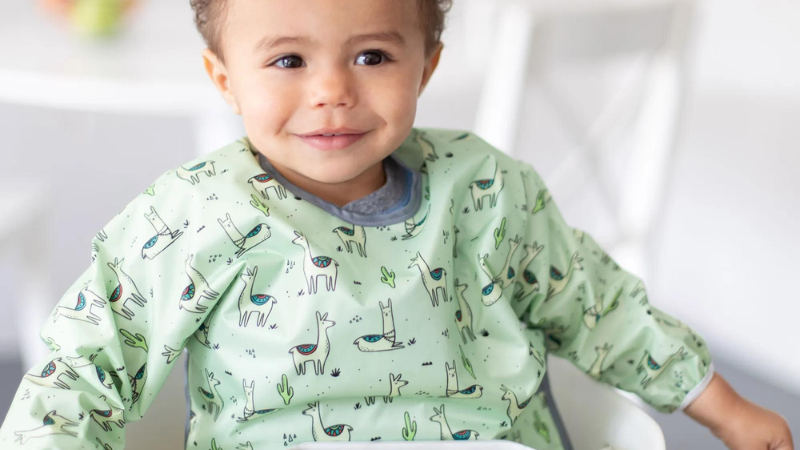
Silicone baby bibs are made from food-grade silicone. Food-grade silicone is FDA-approved and suitable for contact with food. Consequently, it is non-toxic and highly resistant to extreme conditions.
Food-grade silicone’s properties ideal for making baby bibs include its high-temperature resistance, durability, and inertness. In addition, silicone baby bibs can withstand temperatures between -60 and 230 degrees Celsius without losing stability.
Furthermore, they are flexible and durable. So, even if you roll these bibs, they rebound and maintain their initial shape. In addition, silicone baby bibs are inert and do not interact with or contaminate baby food. Also, the material is BPA and lead-free, even if your baby puts the bib in their mouth.
The inert properties of silicone make it safe for babies. It is also oil and liquid-resistant, making meal times fun and less messy. Silicone baby bibs also have non-stick properties, making mold or bacteria growth difficult.
The Benefits of Using Silicone Baby Bibs
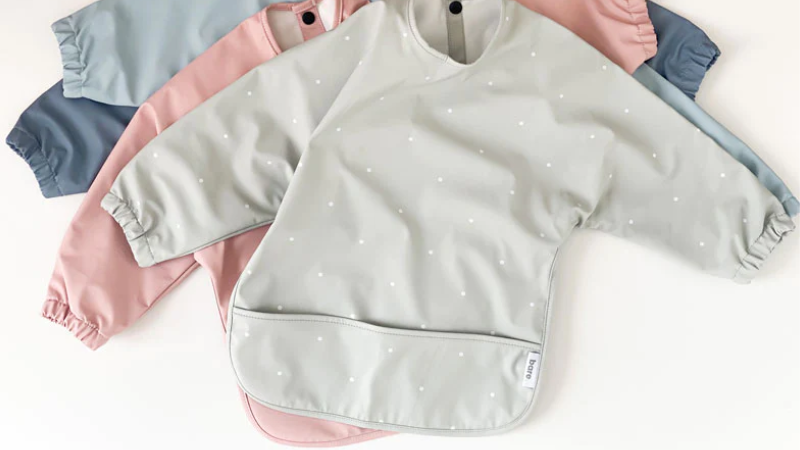
- Easy cleaning. Silicone rubber hardly stains, and it is dishwasher and hand wash safe. You can easily clean your silicone baby bib without scrubbing too hard. You can also use an alcohol-free wet wipe to clean minor food stains.
- Fun colors. Silicone baby bibs come in fun and attractive colors, which are attractive to babies. And because silicone is durable, this material retains its color and will stay bright.
- Safe. 100% silicone is BPA-free and lead-free, making it safe for your baby. BPA and lead are toxic substances that can accumulate in the human body, increasing health risks
- They attached a catch tray. Silicone baby bibs have a design with an attached catch tray. So, the bib catches falling food, minimizing cleaning.
- Easy storage. Silicone baby bibs are flexible. Therefore, they don’t break even if you roll and fold them. As a result, you can easily store and carry your silicone baby bib around, using it whenever necessary.
- Lightweight and secure. Silicone baby bibs come with adjustable clasps that you can fasten around your baby’s neck. And because the material is lightweight, your baby won’t feel it around their neck.
- Durable. Silicone is a flexible synthetic rubber with excellent tensile strength. Therefore, silicone baby bibs are resistant to wear and tear, making them ideal for use over and over again.
Send your inquiry for prompt quotations!
Different Types of Silicone Baby Bibs
Baby bibs are no longer like the standard towel you wrap around a baby’s neck. Now, there are several styles and features suitable for different occasions. The different types of baby bibs include;
- Feeding bibs
- Teething bibs
- Smock bibs
- Drool bibs
- Newborn bibs
- Disposable bibs
- Bandana bibs
Feeding Bibs
Babies play with food, making things messy when they eat. Silicone baby bibs are ideal feeding bibs since they have a trough at the base of the bib. The feeding bib catches food that doesn’t enter your baby’s mouth, keeping their clothes and the floor clean.
Teething Bibs
Teething bibs are not full silicone bibs. Instead, there is a small silicone triangle at the bottom of the fabric. A teething bib is excellent for a baby since the silicone provides something to chew. Fortunately, food-grade silicone is non-toxic and will not harm your baby.
Smock Bibs
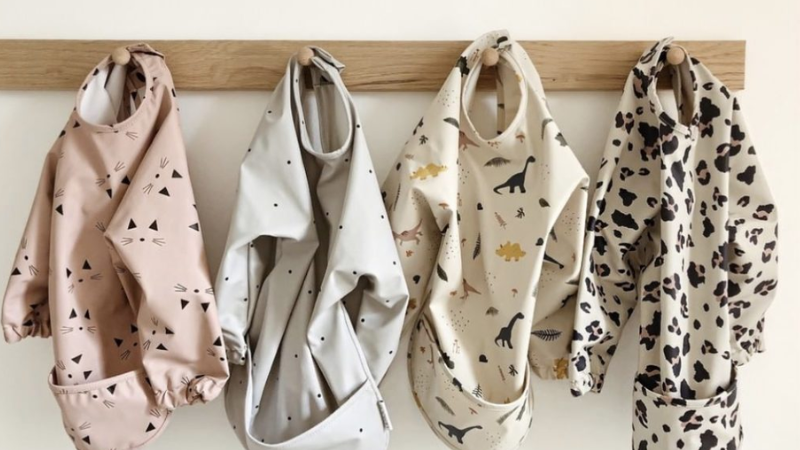
Because smock bibs are long-sleeved bibs, you can wear them just like a shirt for your baby. Smock bibs are waterproof and cover your baby from neck to knee, protecting their clothes. Because they are easy to clean, your child can use smock bibs when eating, painting, or playing with dirt.
Drool Bibs
You can use drool bibs for your baby when nursing or feeding from a bottle. The bib is also great for teething toddlers, protecting their clothes from drool.
Newborn Bibs
Newborn bibs are small and designed to fit babies below six months. These bibs are absorbent, and they are great for use when feeding your baby. Although newborns do not eat solid foods, they tend to vomit during feeding.
Disposable Bibs
As the name suggests, disposable bibs are only meant for single use. You can dispose of them after your baby finishes eating. Disposable bibs are great for traveling or outdoor gatherings. They are also waterproof and absorbent, keeping your child clean during mealtimes.
Bandana Bibs
Bandana bibs are triangle-shaped and catch baby drool to keep their clothes dry. This bib has two layers of fabric and snap fasteners to give your child a comfortable fit. Bandana bibs are stylish, and your baby can start wearing them as early as one to two weeks old.
Send your inquiry for prompt quotations!
How to Choose the Right Silicone Baby Bib for Your Child?
- Consider your baby’s Comfort.
Your baby’s comfort is the first factor in choosing the proper silicone baby bib. The best baby bib should be comfortable and not irritate your baby’s skin. Look out for silicone bibs with 100% silicone. This type of silicone material is tested and certified safe and hypoallergenic.
- Choose the proper size.
Silicone baby bibs come in different sizes for each baby’s developmental stage. First, choose a bib that suits your baby’s age. For example, toddlers use more oversized bibs compared to newborn babies. In addition, ensure that the bib can fit snugly around your baby’s neck with two poppers. If the bib is too tight, it will be uncomfortable; if it is too loose, your child can easily remove it.
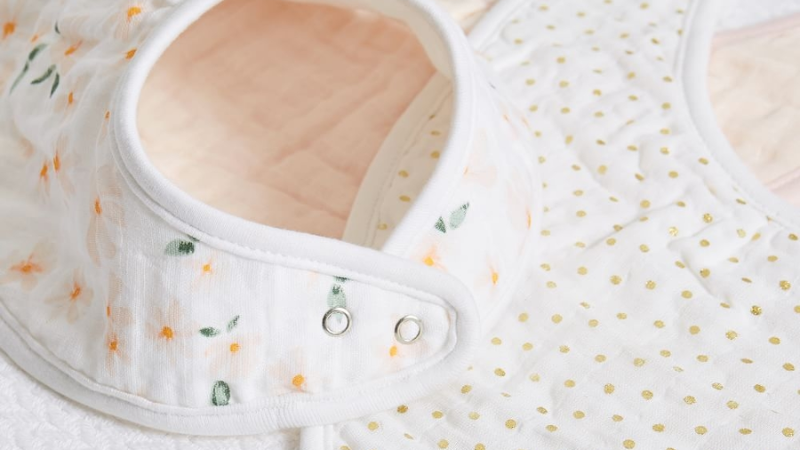
- Look out for compact bibs.
Compact bibs are easy to fold and store without taking up much space. It is best to choose silicone bibs that you can easily fold and store
- Consider Maintenance
The best baby bibs are easy to maintain. You should be able to wash your baby’s bib with mild soap and warm water without scrubbing excessively. Usually, silicone baby bibs are easy to clean, and you can always wipe off minor food stains with an alcohol-free wet wipe.
- Look out for absorbency.
The purpose of a baby bib is to protect your child’s clothes from drool, vomit, and spilled food. So, if the bib is not absorbent enough, it defeats its purpose. Silicone baby bibs are absorbent, keeping heavy stains away.
Tips on How to Wear Silicone Baby Bib
Wearing a silicone baby bib is pretty straightforward. These bibs come with an adjustable strap. Tips for wearing a silicone bib for your baby include;
- Gently bring the bib’s ends around your baby’s neck, then secure it.
- Ensure it is snug and not too tight. You can place a finger or two to feel how tight the bib is
- When your baby is done eating, unfasten the bib, clean it, and store it for subsequent use.
Send your inquiry for prompt quotations!
The Best Way to Clean and Store Silicone Baby Bibs
You can hand-wash or use a dishwasher for your silicone baby bib. Cleaning and storing silicone baby bibs properly ensures they maintain their colors and last as long as possible. Ensure you don’t use abrasive cleaners or sponges when washing the bibs. These can scratch the silicone’s surface.
Instead, use warm water and dish soap. Soak and wash your baby’s bib in warm soapy water, rinse, and air dry. When using a dishwasher, use only the top of the rack. Also, avoid using washing machines for your baby’s bib.
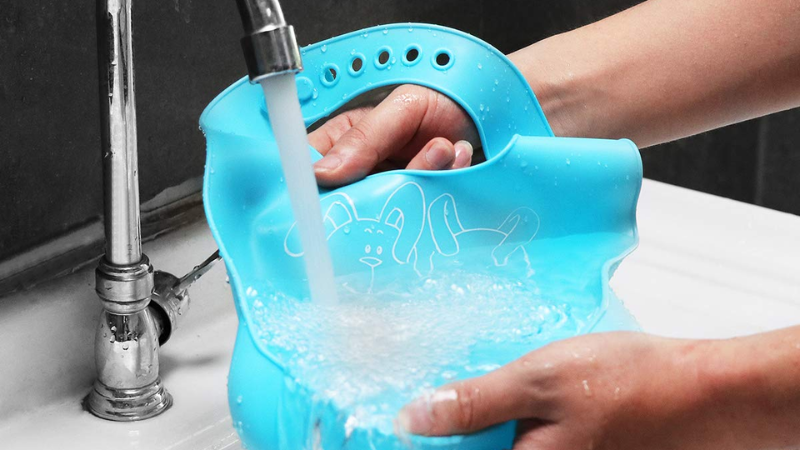
Furthermore, you can store your baby bibs in a clean and dry area. You can keep them in a drawer or hang them.
FAQs about Silicone Baby Bibs
1. Are Silicone Baby Bibs Safe for Babies?
Yes. Silicone baby bibs are safe, provided they are manufactured from 100% silicone. Substandard silicone has impurities that may be harmful to your baby. Therefore, before purchasing a baby bib, ensure you verify that it is food-grade silicone. You can ascertain the quality of a silicone baby bib with the pinch test.
The pinch test requires you to pinch, stretch, and twist the bib. If the silicone turns white, it contains harmful chemicals and is unsafe for your child. Quality bibs are flexible and rebound to their original shape and size after the pinch test.
2. Do Newborns Need Bibs?
Although bibs are not necessary for newborns, it is excellent to have one handy. This is because your baby may drool or vomit during bottle feeding, ruining their clothes. However, if you use a bib, only the bib gets soiled, and you can wash it instead of changing your baby’s outfit.
3. How Long Should Your Baby Use a Bib?
The duration of using the bib depends on your baby’s age. As an infant, a newborn bib and a drool bib are great; you can keep using them while your baby breastfeeds. Then around six months, you can start using feeding bibs to handle food spills.
4. How Often Should You Wash Your Silicone Baby Bib?
It is best to rinse your baby’s bib after every use. You should also deep wash the bib one to three times a week. Washing dislodges food and saliva that are embedded on the bib’s surface. Without proper cleaning, the saliva can become a breeding ground for bacteria. Deep wash your silicone baby bib in the dishwasher or soak it in warm water and mild soap. After rinsing, leave the bib out to dry.
5. Should Your Baby Wear a Bib while Sleeping?
No. It is essential to constantly tend to your baby whenever they are wearing a silicone baby bib. Bibs pose the danger of suffocation, especially when your baby is sleeping. Permanently remove the bib whenever your baby is sleeping.
6. What is the Best Closure for a Baby Bib?
Baby bibs may have Velcro or snap closures. When purchasing bibs, ensure you look out for baby-friendly Velcro. Otherwise, you may buy a bib that could irritate your baby’s skin if unfastened.
Furthermore, adjustable snap closures are the best for baby bibs. With this type of closure, you can ensure that the bib fits snugly around your baby’s neck without irritating their skin.
Send your inquiry for prompt quotations!
Conclusion
Silicone baby bibs are comfortable, easy to clean, and durable. You don’t have to worry about your baby spilling food on the floor or staining their clothes. When choosing baby bibs, consider your child’s age and comfort. After every use, clean the bib with warm water and dish soap. Avoid using a washing machine or abrasive cleansers so as not to scratch the bib’s surface.
Order Your Customized Silicone Products
You can get 100% silicone rubber products from reputable manufacturers like Hongju. We provide all-inclusive solutions in manufacturing high-performance rubber products. With our top-of-the-line manufacturing methods, we can produce silicone baby bibs and any other consequence of your choice in no time.
Contact us today for a catalog of our products and capabilities!